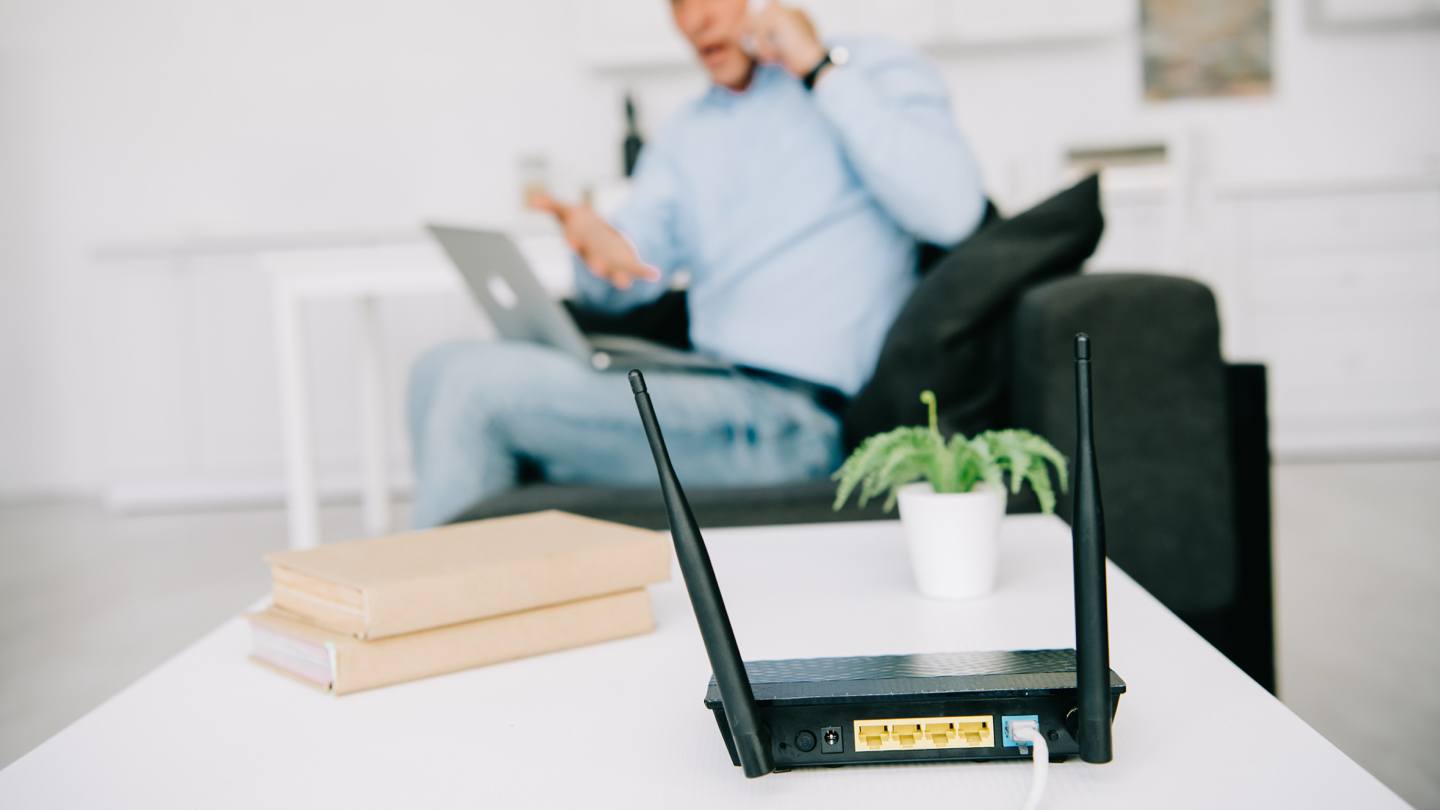Frustrated by a slow connection? Unless your home is located in a rural area with few neighbors, this is likely something that affects you. But before we look into what might interfere with your Wi-Fi, let’s discuss what it is.
What is Wi-Fi?
In regular-people terms, Wi-Fi allows your electronic devices – smartphones, tablets, or laptops – to exchange data or communicate using radio waves that essentially turn your space into an internet network.
And just like visible light can be obstructed by certain materials, so can your Wi-Fi signal. Air or clear glass, for example, lets light pass through with little problem, while other materials, like water or tinted glass, only let some light through. Wood and metal, though, completely block the light.
What affects signal strength?
Wi-Fi communication occurs in the 2.4, 3.6 and 5 GHz frequency bands. The two most common sources of wireless network interference are 2.4 GHz cordless phones and microwave ovens.
People are so reliant upon fast, reliable Wi-Fi these days, it’s no wonder Benjamin Finio, lecturer in the Sibley School of Mechanical and Aerospace Engineering at Cornell University, created a science experiment for young students to look into what causes interference in signals.
Can a neighbor’s Wi-Fi mess with your speed?
Wi-Fi at certain ranges is like really congested highways. If you use a 2.4 GHz router and live in a densely populated area, like an apartment complex or a long row of townhomes, your neighbors’ Wi-Fi networks could interfere with yours. This bogs down the network and may negatively impact device performance.
If multiple wireless networks are competing for the same channel, this can cause problems. To fix this, you may want to change your router’s wireless channel.
WifiInfoView is a free tool for PCs that shows you information about the Wi-Fi networks in your neighborhood, including their frequencies and signal channels. Once downloaded, access the Channel header and sort by Wi-Fi channel. You should be able to see if channel 6, for example, looks cluttered and you should consider switching to channel 1.
For a Mac, hold down the Option button and click on the Wi-Fi icon. Then, select Open Wireless Diagnostics. Select Window, then Scan, then Scan Now, and your computer will indicate the best 2.4 and 5 GHz channels for your router. For more details on that, click here.
Your walls may be affecting your signal
Wi-Fi signals can pass through walls and other obstacles relatively easily – in theory. But in reality, some walls, like concrete (think: dorms), are thicker and may cause the slowing down or blocking of signals. Basic building materials like drywall, plywood and glass are easily penetrable, but harder, denser materials, such as brick, metal, tinted glass, or stone, may cause problems. If your building’s walls are made up of these materials, common in older buildings, your wireless speed and range may be compromised. Metals absorb Wi-Fi signals.
Near an elevator? Elevators also block Wi-Fi to a great extent.
Household appliances could be the culprit, too
Some smaller household appliances can contribute to wireless interference, including cordless phones, baby monitors and even your microwave. Depending on the severity of the obstruction, you may even have the wireless network cut out when the microwave or cordless phone is in use.
Problems with cordless phones can be solved by replacing your phones with phones that operate on a different frequency, such as 900 MHz or 1.9 GHz. Cordless phones using the 2.4 GHz frequency will interfere with wireless networks.
Other potential sources of interference include fluorescent bulbs, 2.4 GHz video cameras, and Bluetooth radios.
Looking like stormy weather?
Perhaps not surprisingly, weather events, like rain, snow, and even heavy winds, can obstruct wireless signals. Trees are notorious for absorbing signal energy.
What should you do to prevent interference?
According to tech expert Chris Hoffman, where and how you position your wireless router can boost your signal strength.
To achieve the best signal possible at home, Hoffman suggests the following tips:
- Place the router in the middle of your house, not a side room. This makes the signal more broadly accessible to all areas of your home.
- Stand your router straight up and make sure, if you have an antenna, that it’s in the upright position, too, even though it can move horizontally in many cases. Facing up is generally the best position, he says.
- Get your router up off the floor and store it in an elevated position, on a desk or bookcase, for example.
Hoffman also suggests you heed the materials near the router. Routers next to metal filing cabinets or desks or walls, for example, could cause some problems. (Note: Signals can travel through wood, but metal will likely obstruct them.)
How can I fix Wi-Fi interference?
If you’ve identified Wi-Fi interference on your network, consider switching between 2.4 GHz and 5 GHz bands, moving your router away from walls and putting it in a central spot, looking for router updates or adding a Wi-Fi extender.
Wi-Fi interference FAQs
Use a signal-checking tool on a smartphone or laptop to check for Wi-Fi interference. The tools can help you find weak or dead spots and possibly lead to the source of the interference.
Many things can interfere with your Wi-Fi signal, including your microwave, a satellite overhead, cordless phones, metal or concrete walls, Bluetooth, baby monitors, tablets, two-way radios and more.
If your network slows down, won’t work in some spots of your house, you see your device having trouble streaming or loading websites or your device is constantly trying to reconnect to the network, chances are you have some interference.
Find broadband news and studies on trends in the internet industry on Allconnect’s news hub and research hub.

Written by:
Camryn Smith
Cammy is a writer with Allconnect, growing her broadband industry knowledge for over a year on the internet marketplace. Her expertise lies in home internet and broadband service with a focus on providers, plans…
Read more
Edited by:
Robin LaytonEditor, Broadband Content
-
Featured
![The best Wi-Fi extenders of 2024]() The best Wi-Fi extenders of 2024 Camryn Smith — 10 min read
The best Wi-Fi extenders of 2024 Camryn Smith — 10 min read -
Featured
![Troubleshooting Wi-Fi connection issues: Why can’t I connect to a network?]() Troubleshooting Wi-Fi connection issues: Why can’t I connect to a network? Camryn Smith — 6 min read
Troubleshooting Wi-Fi connection issues: Why can’t I connect to a network? Camryn Smith — 6 min read -
Featured
![Allconnect’s 2024 broadband customer satisfaction report]() Allconnect’s 2024 broadband customer satisfaction report Camryn Smith — 8 min read
Allconnect’s 2024 broadband customer satisfaction report Camryn Smith — 8 min read
Latest
-
Thursday, July 25, 2024
Worried about losing your signal? This is how to keep your satellite dish cleanDavid Anders — 6 min read
-
Tuesday, July 23, 2024
The best free TV and movie streaming services 2024Camryn Smith — 5 min read
-
Tuesday, July 23, 2024
Everything you need to know about internet speedsRobin Layton — 8 min read






